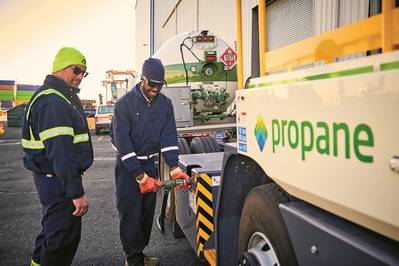Getting Started with Propane: Port-Side Refueling & Storage
Emissions regulations continue to become more stringent for ports, pushing more port authorities and terminal operators away from diesel and gasoline and toward alternative energy sources like propane. Capable of powering essential port applications like yard tractors, forklifts, and other cargo handling equipment (CHE), propane is available now to support ports in achieving emissions reduction goals.
The Propane Education & Research Council often gets questions about what refueling infrastructure looks like and what to expect when transitioning to propane-powered terminal equipment. Continue reading to learn more about port-side refueling options and energy source storage.
Refueling options
Propane suppliers understand that ports need to have a customized refueling plan and can assist with one of several options. Whether terminals have just a few yard tractors and forklifts or a robust shore power setup with generators, there are a variety of combinations available to ensure efficient and accessible refueling wherever it’s needed in a port.
On-Site refueling
Few things are better than the convenience of having a centralized refueling location. With on-site refueling, propane is delivered straight to the port by a local propane supplier. In most cases, port authorities can purchase the equipment or lease it from the local propane supplier in exchange for a fuel contract that locks in a set price per gallon for a duration beneficial to both parties.
On-site refueling includes large capacity fuel storage tanks equipped with a pump, meter, and one or more dispensers. This is a great option for growing fleets since these options are fully customizable and scalable to meet the needs of any operation with no necessary electrical or site upgrades. While the permanent station is being built, many propane suppliers will also set up temporary refueling sites for the fleet when necessary.
Temporary refueling
Temporary refueling setups are a great option when a port authority or terminal operator needs to place refueling sites throughout the port, but is not ready to build multiple permanent refueling locations. The setup includes a dispenser, pump, and a fuel storage tank mounted on a trailer that can be delivered to designated locations or work sites. The setup is owned by the local propane supplier, but fleets can refuel using the tank and dispenser for as long as necessary. Temporary refueling setups are also ideal for expansion projects or repairs because they can be parked directly at the work site, requiring fewer refueling trips and less wasted time.
Mobile refueling
Mobile refueling is one of the most common refueling solutions for operations spread out across a large area. Port authorities can work with a propane supplier to customize an on-site refueling plan that utilizes a propane bobtail delivery truck. Costs and situations will vary with this option, so check with a propane supplier for details and pricing.
Footprint
Because port terminals typically store fuel in above-ground storage tanks and refuel cargo handling equipment with mobile units, shelf-stable energy sources like propane are essential. Large ports may even store up to 100,000 gallons of reserve fuel on-site to provide a buffer against supply disruptions.
With a propane refueling setup, port authorities benefit from minimal infrastructure upgrades and space requirements. A propane tank requires approximately the same space as existing diesel refueling pads.
As a clean energy source with a variety of refueling setup configurations, it’s easy for port authorities to make significant steps toward emissions reduction goals with propane.












